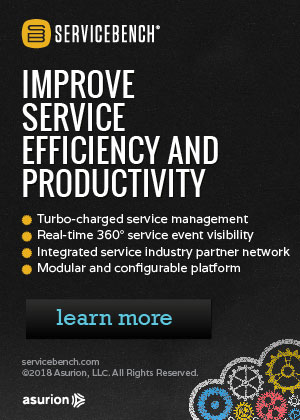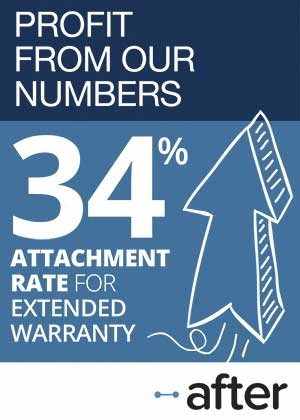Midyear Computer Industry Warranty Report:Even though numerous industry players have been acquired or have gone private, the remaining manufacturers have continuously cut their warranty expenses from one year to the next. But then along came the iPhone, and now Apple's frequent ups and downs are dominating the industry's statistics.
Over the past 15 years, computer makers and data storage system manufacturers have proven to be very successful at reducing their warranty expenses. Over that time period, they have cut their warranty expense rates almost exactly in half, from a range of two-to-four percent back then to one-to-two percent now.
Starting in early 2003, we began gathering four essential metrics for all U.S.-based computer and data storage manufacturers: warranty claims paid per quarter, accruals made per quarter, warranty reserves held at the end of each quarter, and product sales made per quarter. Using claims, accruals, and product sales, we calculated two additional ratios: claims as a percent of sales, and accruals as a percent of sales.
Over the 14-1/2 years since 2003, we've tracked 26 different computer manufacturers and 44 data storage manufacturers, although most of them have since gone out of business, gone private, or have been acquired by other companies. On the computer side, the largest remaining companies we're tracking include Apple Inc., IBM Corp., and the two successors of Hewlett-Packard Company: HP Inc. and Hewlett Packard Enterprise Co. On the data storage side, the largest remaining players include Seagate Technology, Western Digital Corp., NetApp Inc., Brocade Communications Systems Inc., and Quantum Corp.
On the computer side, the major departures include Dell Inc., which was taken private; Gateway Inc., which was acquired by Acer; Sun Microsystems Inc., which was acquired by Oracle; and both Silicon Graphics International Corp. and Palm Inc., which were acquired by HP. Also, Unisys Corp. simply stopped reporting its hardware warranty expenses.
Lack of Warranty Reporters
While a handful of international computer manufacturers do report their warranty expenses, most do not. We have no warranty data from Lenovo, Toshiba, Fujitsu, Asus, or Acer, and only company-wide data from consumer electronics giants Sony and Panasonic, which do not segment their computer-only warranty expenses. Therefore, we have no warranty data for well over half the global computer industry, and will not be trying to size the industry's worldwide warranty expense totals.
On the data storage side, the major departures include SanDisk Corp., which was acquired by Western Digital; Maxtor Corp., which was acquired by Seagate; EMC Corp., which was acquired by Dell; and Storage Technology Corp., which was acquired by Sun, which was then acquired by Oracle. Dell and Oracle do not report their product warranty expenses, but the other acquirers still do.
In the charts below, we're not making any adjustments for all the companies that dropped off the list. These are simply the raw totals of the remaining companies. In Figure 1, we're looking at the quarterly claims payments of the computer and data storage manufacturers over the 58 quarters through the middle of 2017.
Figure 1
Computer Industry Warranties
Claims Paid by U.S.-based Manufacturers
(in US$ millions, 2003-2017)
Note that despite all the industry exits, the total amount of claims paid has remained relatively steady at a level just above or just below $1.5 billion per quarter. Of course, with the inclusion of Apple, there is much more iPhone than Macintosh in the chart. Apple is by far the largest claims payer in the industry, reporting in excess of $1 billion in payments per quarter for most of the past five years. And in fact, the industry peak came in 2013, when Apple first passed that ten-digit threshold.
Next week, we plan to do an in-depth analysis of Apple's product warranty and service contract revenue and expenses, assuming its annual report is published soon. Normally, it appears at the end of October, so it's a bit behind schedule this year (the company just announced its earnings today). We already have third quarter reports from both HP Inc. and Hewlett Packard Enterprise, and are awaiting their annual reports for the fiscal year that just ended on October 31. But those annual reports are not likely to be published until mid-December.
Through the middle of 2017, claims are down sharply for both the computer makers and the data storage manufacturers. The $1.32 billion paid by the remaining computer manufacturers in the second quarter is their lowest quarterly total since 2011. The $72 million paid by data storage manufacturers is their lowest quarterly total ever. No doubt, this is primarily caused by the departures of so many large contributors from the list of reporting companies.
Among those that remain, however, there were some sizeable reductions in claims payments. Seagate, NetApp and Quantum reduced their quarterly claims payments by more than 20%, while Apple, HP, Western Digital, and IBM reduced their claims payments by 10% or more. Hewlett Packard Enterprise reported a slight increase in claims payments, compared to the previous year.
Warranty Accruals
For the past six years, Apple has been maddeningly inconsistent with its warranty accruals, which causes the chaos that can be seen in the data of Figure 2. In its first fiscal quarters of those years, which cover the months of October through December, the company sets aside unusually large amounts of warranty accruals. For instance, at the end of calendar 2013, 2014, and 2016, it set aside more than $2 billion in warranty accruals. This is what causes the periodic spikes in the chart below.
Figure 2
Computer Industry Warranties
Accruals Made by U.S.-based Manufacturers
(in US$ millions, 2003-2017)
We will delve into the Apple data in more depth next week. Suffice it to say that the company has an irregular schedule for warranty accruals, which is not the case for its quarterly warranty claims totals. Normally, accruals are proportional to sales, but Apple accrues as much as 3.9% of its hardware revenue during the spikes and as little as 1.0% of its revenue during the other quarters of the year. In other words, it's not a seasonal pattern caused by brisk holiday sales of iPhones.
Among the others, Brocade and Quantum cut their accruals by about 30%, and both IBM and Hewlett Packard Enterprise cut their accruals by 11%. HP Inc. raised its accruals by 5%, and both Western Digital and Seagate increased their quarterly accruals by more than 10%.
There were proportional sales declines at IBM and Hewlett Packard Enterprise, and a proportional sales increase at HP Inc. But Western Digital saw a massive 47% rise in sales, while Seagate saw a slight decline. NetApp, whose accruals were exactly the same in both 2016 and 2017, saw only a small change in sales.
Warranty Reserves
The midyear balance in the warranty reserve funds of these computer and data storage companies was down significantly. The computer companies, at $5.85 billion, registered their lowest balance since 2012. But once again, the volatility of Apple was what was driving that balance up and down. At times in 2014 and 2015, Apple held more than $5 billion in warranty reserves. By midyear 2017 its balance was down to $4.3 billion.
The warranty reserves of the data storage companies, at $607 million, were down by almost $100 million from a year before. But much of that was due to the disappearance of EMC, which ended the second quarter of 2016 with $136 million on its books before being acquired by Dell.
Figure 3
Computer Industry Warranties
Reserves Held by U.S.-based Manufacturers
(in US$ millions, 2003-2017)
Compared to midyear 2016, the biggest proportional balance increases were seen at Western Digital, Seagate, and Brocade. The largest declines were reported by IBM, HP Inc., and NetApp. Quantum and Hewlett Packard Enterprise kept their balances about the same.
Warranty Expense Rates
Unlike with the charts above, we do adjust for drop-outs when calculating the warranty expense rates detailed in the charts below, in the sense that when a company goes private or is acquired, both its sales and expenses depart with it. Therefore, when expense rates decline, they do so because either the sales of the remaining players rose, or their expenses fell, or both.
It's entirely possible that the reason expense rates are declining is because some of the high-cost manufacturers are among the first to go. For instance, Maxtor and Palm Inc. used to report some spectacularly high warranty expense rates when they were going concerns. When they were acquired by companies with better warranty management skills, the expense rates of those product lines declined.
However, we think there is another reason for the steady declines seen in both Figures 4 and 5: the manufacturers are selling more reliable products with less frequent failures and lower repair or replacement costs. The reason the downward trend seems to end for the computer players in 2013 is once again Apple-related. Sometimes its iPhone warranty costs are high, and sometimes they're low.
Figure 4
Computer Manufacturer Warranties
Average Warranty Claims & Accrual Rates
(as a % of revenue, 2003-2017)
Note that the sum total of the computer manufacturer accruals divided by their sales resulted in a most recent reading of 1.7% for their average accrual rate in the second quarter of 2017. That was only fractionally higher than the low water mark they set a year before. Their claims rate, meanwhile, was just a hair under 2.5%.
Back when we began collecting this data in 2003, the computer makers were spending between 3.5% and 4.0% of their hardware revenue on warranty expenses. By 2012, they'd reduced their expense rates to between 2.0% and 2.5%. The long-term average over 58 quarters is 2.8%, with a standard deviation of 0.5%, which reflects this wide range.
As of midyear, Apple, IBM and HP Inc. were all close to average. Hewlett Packard Enterprise was significantly below average, which is likely due to the fact that the product lines known for their warranty costs went to their better half. Apparently, HPE's servers and storage systems don't generate proportionally as much warranty expense as HP's printers and laptops.
Data Storage Expense Rates
The data storage manufacturers, meanwhile, have always reported lower warranty expense rates. Their long-term average warranty expense rate is 1.5%, with an 0.4% standard deviation. But as can be seen in Figure 5, they're also more consistent in terms of both driving down warranty expense rates and keeping them low. At the end of 2016, they set a new low water mark for both their claims and accrual rates.
Figure 5
Data Storage Manufacturer Warranties
Average Warranty Claims & Accrual Rates
(as a % of revenue, 2003-2017)
For most of the past three years, the data storage companies have been setting aside less than one percent of their revenue in warranty accruals. And now, for the fourth consecutive quarter, their average claims rate has also remained below one percent. And that's as it should be: first the warranty managers report quality improvements and repair cost declines, then the finance managers cut the accrual rates in response, then the claims rate follows suit. There's typically some lag time between each step, and that's exactly what can be seen in Figure 5.
Among the major players, at the midyear mark, Seagate and Quantum were a little above average, NetApp and Brocade were a little below average, and Western Digital was almost precisely at the average level of the industry. But all five were much improved from a year earlier, with the sole exception of Seagate's accrual rate, which rose from 1.1% to 1.2%. But if that's the worst news in the warranty sector of this industry, it doesn't count for much.
| 













